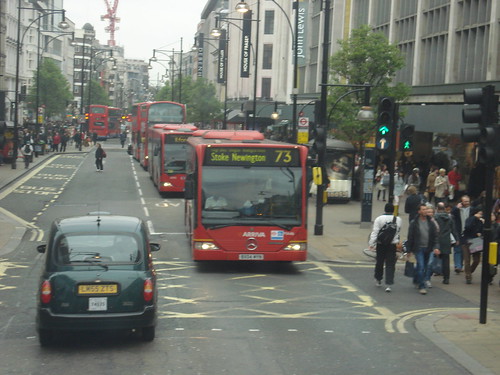
Arriva London MA46 on Route 73, Oxford Circus, 14/04/2011 (© Aubrey)
Before Wrightbus brought out the New Routemaster, or as it's more colloquially known, the Borismaster, Ken Livingstone too had a way to reduce dwell times at bus stops. The same concept of boarding and alighting at any door kept the same. However, Ken Livingstone's way to do this was with buses that were from Germany, with Mercedes-Benz Citaro O530Gs. This particular example was acquired for the 73, when it was converted from AEC Routemasters to the colloquially known "bendy-bus". Based at then new Lea Valley Garage (LV), it served the 73 and the 149. It served on the 73 until 03/09/2011, when the route was converted to Volvo B5LH/Wright Eclipse Gemini 2 operation. That also removed all-door boarding from the route, but not the rarely used bus stop ticket machines in Central London. This example was then painted white and put into more ill-fated service. This time, this was at Arriva Malta, where it ran as BUS 702. By August 2013, however, these buses were forced off the road by the government of Malta, after multiple fires. These buses were then supposed to be sold to Sudan, but this has not materialised since.
Route 73 started out as a King's Cross-Barnes route in 1914. By 1934, the route ran to Stoke Newington and Richmond, based at Tottenham (AR) and Mortlake (M). Until 1988, Stoke Newington-Richmond was the base part of the route. During the 1930s and until 1945, extensions to Kingston (peak hours) and Hampton Court (Summer Sundays) were run. RTs and RTLs were introduced from 1949. From 1958, the route ran as a split route, replacing Route 27A on Sundays, then the Monday-Friday operation of Route 33. Thus, the route ran Hounslow-Kensington and Stoke Newington-Richmond, gaining a Hounslow (AV) allocation from 1958. The Hounslow-Kensington part was basically a renumbering of Route 33. From December 1962, the whole route gradually converted to Routemaster. In 1965, all non-AR/M allocations were withdrawn, and from 1966, the route was retracted from Hammersmith gradually, being replaced by the re-introduction of the 33, and the 281, thus by 1982, the route ran Hammersmith-Stoke Newington, with the route running from AR and Hammersmith (R). When Hammersmith (R) closed, the allocation there moved to Shepherd's Bush (S). From 1987, the Sunday service became OPO with MCW Metrobuses.
From 13th August 1988, the 73 was rerouted at Hyde Park Corner to Victoria, with new route 10 replacing the Hammersmith section. The Sunday service, then operated by Shepherd's Bush, moved to Stamford Hill (SF). Under sectorisation, the route moved to Leaside Buses, which was later purchased by the Cowie Group, eventually known as Arriva. From 1990, the Sunday service was extended to Stamford Hill, ending when the Stamford Hill allocation moved to Tottenham (AR). By this time, a service which was frequent but irregular at times ran to Tottenham Swan via Seven Sisters Station. When the route was converted to articulated buses on 4th September 2004, the irregular service was cut back to Seven Sisters Station. The route also moved to Lea Valley (LV) at this time.
As part of then Mayor Boris Johnson's commitment to withdraw articulated buses, the route was converted to hybrid operation on the 3rd September 2011, with Volvo B5LH/Wright Eclipse Gemini 2s. 73 was also cut back to Stoke Newington full-time, and re-allocated to Stamford Hill (SF). Borismasters then beckoned on the 73 from May 2015. The most recent route change happened just over a month ago, when the 73 was withdrawn between Oxford Circus and Victoria, replaced by Route 390. The 390 ironically was introduced from a split of the 10, made from the split of the 73.

Nice post thanks for sharing it.
ReplyDelete